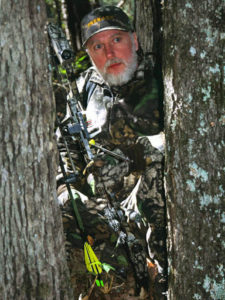 My friend Jim Crumley, who created Trebark back in 1980, is almost single-handedly responsible for the camouflage craze of the last 40 years. Retired now and loving it, Jim has two passions: Managing whitetails and bowhunting them on his 300-acre property along the James River in southwestern Virginia.
My friend Jim Crumley, who created Trebark back in 1980, is almost single-handedly responsible for the camouflage craze of the last 40 years. Retired now and loving it, Jim has two passions: Managing whitetails and bowhunting them on his 300-acre property along the James River in southwestern Virginia.
“Managing your land for deer is not rocket science,” Jim says. In fact, the more he has worked his mountain land over the years, the simpler his plan has become. “The easier and more cost-effective you make your management plan, the more you’ll stick with it, the harder you’ll work and the better your results.”
Jim does a lot of his work with a tractor and a bush-hog right now in the summer.
“If you’ve got a pasture or overgrown field on your property, one of the best things you can do is go out and mow 5 or 6 strips through the weeds, maybe 100 yards long and 20 yards wide,” he says. “Leave strips of the larger and taller vegetation, like blackberries and greenbrier, between the mowed rows.”
This simple task creates diversity of food and edge that whitetails love. When late-summer rains come before or during bow season, weeds and forbs pop up in the mowed strips, and deer love the new and succulent food source.
One of Jim’s go-to strategies is to hang bow stands in corner trees where the mowed strips intersect a wood line.
“Many days I see deer walk right through my soybeans and green plots to get to the tender forbs coming up in the low, cleared strips,” Jim says. “With just some tractor time and some mowing, you create more food for the deer, and more spots on a nearby wood line where you might shoot a buck.”
Photo of Jim Crumley @Night Hawk Publications





Simple, yet completely effective. I think if you took some simple 12-12-12 (or, similar) fertilizer and spread it in those strips after mowing you could boost the attractiveness even more. These are veritable “food plots” of the natural variety. As much as I love creating, working, and caring for intentional foodplots one must never forget that the majority of a whitetail’s diet will always consist of at least some wild forbs and plants that we most often overlook, or don’t even think about. This is especially so in areas without abundant agriculture, but also applies to areas with an abundance of agriculture. I see it here in Indiana; especially in the late season and into the spring green up. Whitetails eat a tremendous variety of naturally-occurring forms and “weeds”….way more than we think in many cases. Good hunting everyone! It’s been a hot, dry summer here in NE Indiana. Can’t wait for the cool down and rains that are coming in about a month, or so.